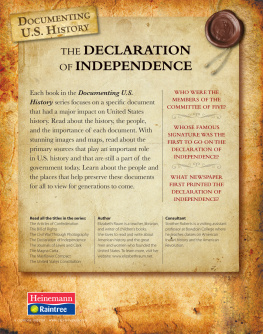Documents
of Freedom
A Look at the Declaration of
Independence, the Bill of Rights,
and the U.S. Constitution
Gwenyth Swain

This title is a revised edition of Declaring Freedom by Gwenyth Swain. It has been
revised solely by the publisher and without the assistance of Ms. Swain.
Copyright 2012 by Gwenyth Swain
All rights reserved. International copyright secured. No part of this book may be
reproduced, stored in a retrieval system, or transmitted in any form or by any means
electronic, mechanical, photocopying, recording, or otherwisewithout the prior written
permission of Lerner Publishing Group, Inc., except for the inclusion of brief quotations in
an acknowledged review.
Lerner Publications Company
A division of Lerner Publishing Group, Inc.
241 First Avenue North
Minneapolis, MN 55401 U.S.A.
Website address: www.lernerbooks.com
Library of Congress Cataloging-in-Publication Data
Swain, Gwenyth, 1961
Documents of freedom : a look at the Declaration of Independence, the Bill of
Rights, and the U.S. Constitution / by Gwenyth Swain.
p. cm. (Searchlight booksHow does government work?)
Includes index.
ISBN 9780761365143 (lib. bdg. : alk. paper)
1. United States. Declaration of IndependenceJuvenile literature. 2. United
States. ConstitutionJuvenile literature. 3. United States. Constitution.
1st10th AmendmentsJuvenile literature. 4. United StatesPolitics and
government17751783Juvenile literature. 5. United StatesPolitics and
government17831789Juvenile literature. I. Title.
E221.S94 2012
973.313dc22 2010041922
Manufactured in the United States of America
1 DP 12/31/11

Contents
SEEKING
FREEDOM
THE DECLARATION OF
INDEPENDENCE
Chapter
SEEKING
FREEDOM
In the 1600s, people from Europe settled on the eastern coast of North America. Their settlements were called colonies.
Settlers from Europe build a
home and carry supplies to shore
in this drawing. What were the
Europeans settlements called?
For many years,
Great Britain and its
king ruled the thirteen
colonies set up in
North America. That
meant people in these
colonies had to obey
Britains laws.
By the mid-1700s,
many colonists
had grown tired of
obeying Britain. They
didnt like Britains
king, George III. The
colonists had come
to America to find
freedom. But they
had to obey the king
whether they liked it
or not.
King George III ruled
Britain from 1760 to
1820. He also ruled the
colonies in North America.
The part of Britains government that makes laws is
called Parliament. Colonists also had to obey Parliament.
People in Britain had to obey Parliament too. But they could
vote for Parliaments members. The colonists couldnt.
This painting shows
Parliament meeting
in the early 1700s.
Stamp Act
In 1765, Parliament
passed the Stamp Act.
This law said colonists
had to pay a tax on
paper goods. The
Stamp Act angered
the colonists. They
protested. In 1766,
Parliament ended
the law.
People in New York protest
the Stamp Act by burning
paper goods.
Tea Tax
Colonists rejoiced. But
not for long. A tax
on tea followed. The
colonists protested this
tax too. In 1773, some
of them threw tea in
the harbor of Boston,
Massachusetts. They
chose to throw away
the tea rather than pay
the tax.
Colonists in Boston protested
the tea tax by dumping tea
in the harbor. They dressed
like Native Americans to hide
who they were.
In 1774, Parliament passed laws to punish colonists.
Boston Harbor was closed until colonists paid for the
tea theyd thrown in the water. British soldiers marched
through Bostons streets. Colonists had to let the
soldiers eat and sleep in their homes.
British soldiers stay
in a colonists home
against his will.
Time for Change
Colonists grew so angry that they sent leaders from
each colony to a meeting. It was called the Continental
Congress. It took place in Pennsylvania in 1774. At the
meeting, the leaders talked about what to do.
This drawing from
1783 shows the
Continental Congress
meeting in 1774.
Colonists get ready to fight back
by taking weapons from British
troops in New York in 1775.
Most colonists still hoped to get along with Britain. But
in 1775, more British troops came to the colonies. Some
colonists thought war might break out. They decided to
get ready to fight.
No one knows who fired the first shots in Lexington
and Concord. But in those Massachusetts towns, both
colonists and British troops died. King George said what
most colonists already knew. The Americans were in
rebellion, or an armed fight, against him.
The Battle of
Lexington took place
on April 19, 1775.
Still, most colonists
didnt want to break
away from Britain. They
just wanted the taxes to
end. But in 1776, a writer
named Thomas Paine
wrote a pamphlet called
Common Sense. It
called for independence,
or self- rule.
The pamphlet
changed the colonists
views. In the summer
of 1776, colonial leaders
made a declaration about
independence. And they
made history too.
Thomas Paine wrote Common
Sense in 1776. It encouraged the
colonists to seek independence.

























